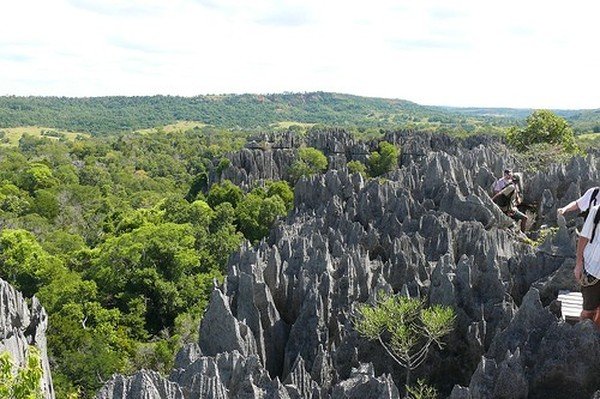|
|
Stone Forest In Madagascar, Manambulu - Bemaraha
|
The combination of southeastern trade winds and northwestern monsoon winds produce a hot rainy season (November—April) with frequently destructive cyclones, and a relatively cooler dry season (May—October). Broadly speaking, the climate is tropical along the coast, temperate inland, moderately dry in the west, and arid in the south. Rain clouds originating over the Indian Ocean discharge much of their moisture over the island's eastern coast where precipitation as heavy as 3,800 mm (150 in) per year supports the area's rain forest ecosystem. The central highlands are both drier and cooler, while the west coast is drier still, with high aridity in the southwest and southern part of the island where a semi-desert climate prevails. Annual cyclones cause regular damage to infrastructure and local economies as well as loss of life. The most destructive since 1927 was Cyclone Geralda (February 2–4, 1994) which caused over 70 fatalities and left over 500,000 people homeless with the damage estimated at US$45 million.
• Ecology
As a result of the island's long isolation from neighboring continents, Madagascar is home to a vast array of plants and animals, many found nowhere else on Earth. Approximately 80% of all plant and animal species found in Madagascar are endemic, including the lemur infraorder of primates, the carnivorous fossa and three avian families. This distinctive ecology has led some ecologists to refer to Madagascar as the "eighth continent", and the island has been classified by Conservation International as a biodiversity hotspot.
Over 10,000 plant species are native to Madagascar, of which 90% are found nowhere else in the world. Seven plant families are only found there, the highest number of any biodiversity hotspot in the world. The plant family didiereaceae, composed of four genera and 11 species, is limited to the spiny forests of southwestern Madagascar. Four-fifths of the world's pachypodium species are endemic to the island. Three-fourths of Madagascar's 960 orchid species are found there alone, as are six of the world's eight baobab species. The island is also home to around 170 palm species, three times as many as are found on mainland Africa; 165 of these are endemic. Many native plant species are used as effective herbal remedies for a variety of afflictions, including the Madagascar periwinkle, which has recently been established as the most effective treatment for leukemia and Hodgkin's disease. The traveler's palm, endemic to the eastern rain forests, is highly iconic of Madagascar and is featured in the national emblem as well as the Air Madagascar logo.
|
|









